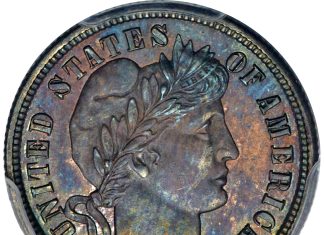It was a 1796 Half Dollar, 15 Stars AU58 PCGS, a stunning coin featuring one of the rarest designs in all of U.S. coinage, that emerged from spirited bidding as the top lot in Heritage Auctions’ March 17-20 Signature® ANA U.S. Coin Auction, with a final price realized of $207,000.

The auction realized more than $9.682 million, all told, not counting continuing After Auction sales. All prices include 15% Buyer’s Premium.
"These are excellent results," said Greg Rohan, President of Heritage Auctions. "We’re especially pleased with the high sell-through rate, and the overall prices significantly exceeded expectations, bolstered by the fine performances by early American silver and copper, as well as a few key gold pieces that showed the enduring strength of that market."
More than 5,200 collectors competed for the 5,378 lots in the auction, adding up to the $9.86 total, which translates into a 93.410% sell-through rate by dollar value.
A famous Colonial rarity, the Breen example 1C Washington Roman Head Cent, PR64 Brown PCGS, occupied the second spot in the overall tally of the Sacramento auction, bringing $100,625 from an erudite collector.

"This is an important coin and collectors clearly responded with a price that exceeded the $100,000 mark," said Rohan. "Given that the exact number of surviving Washington Roman Head cents is unknown, although the total is clearly small, this is a smart buy that will now occupy a prized spot in an advanced collection."
A trio of coins commanded $80,500 each in the auction. A 1796 Quarter Dollar, MS64 NGC part of the only issue of its denomination bearing the Small Eagle reverse, was the first among equals, while the Eliasberg specimen of the 1806 B-9 Draped Bust Quarter, MS66, the finest known of its type, a true numismatic prize with few equals, followed.

Rounding out this valuable triumvirate was a Civil War-Era 1863 $3 Three Dollar gold piece, PR66 Ultra Cameo, similarly the finest of its kind, struck in Philadelphia the same year the Battle of Gettysburg was fought less than 150 miles away.

Further Sacramento ANA US coin auction highlights include, but are not limited to:
1915-S Panama-Pacific 50 Dollar Octagonal MS63 PCGS: Realized: $74,750.
1796 50C 15 Stars Fine 15 PCGS. CAC. O-101, R.5.: Realized: $74,750.
1794 H10C MS65 PCGS Secure. V-1, LM-1, R.6.: Realized: $63,250.
1793 Chain 1C AMERICA XF40 PCGS. S-3, B-4, Low R.3.: Realized: $63,250.
1862-S $2 0 MS63 NGC. CAC.: Realized: $57,500.
About Heritage Auctions
Heritage Auctions, headed by Steve Ivy, Jim Halperin and Greg Rohan, is the world’s third largest auction house, with annual sales more than $600 million, and 500,000+ registered online bidder members. For more information about Heritage Auctions, and to join and gain access to a complete record of prices realized, along with full-color, enlargeable photos of each lot, please visit HA.com.





